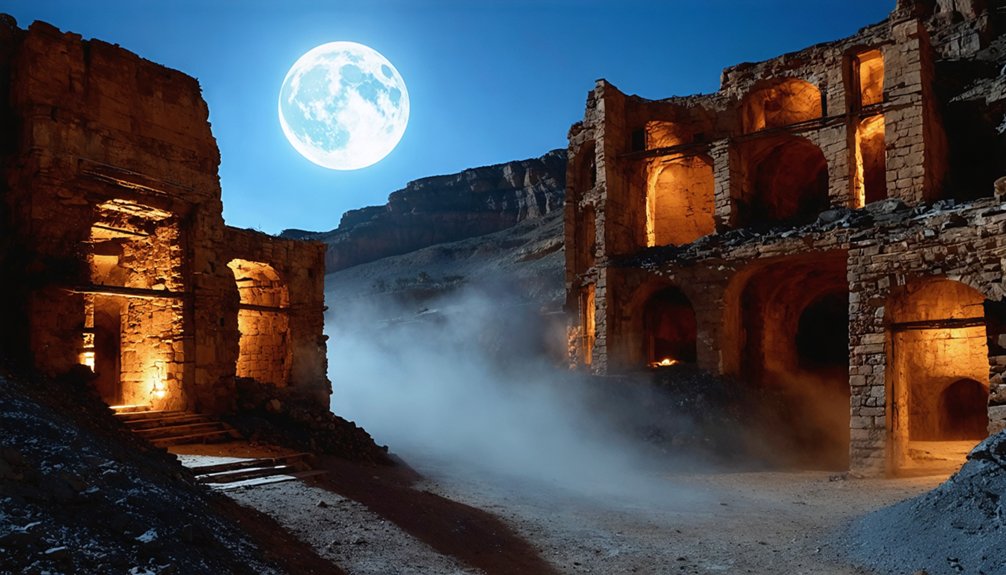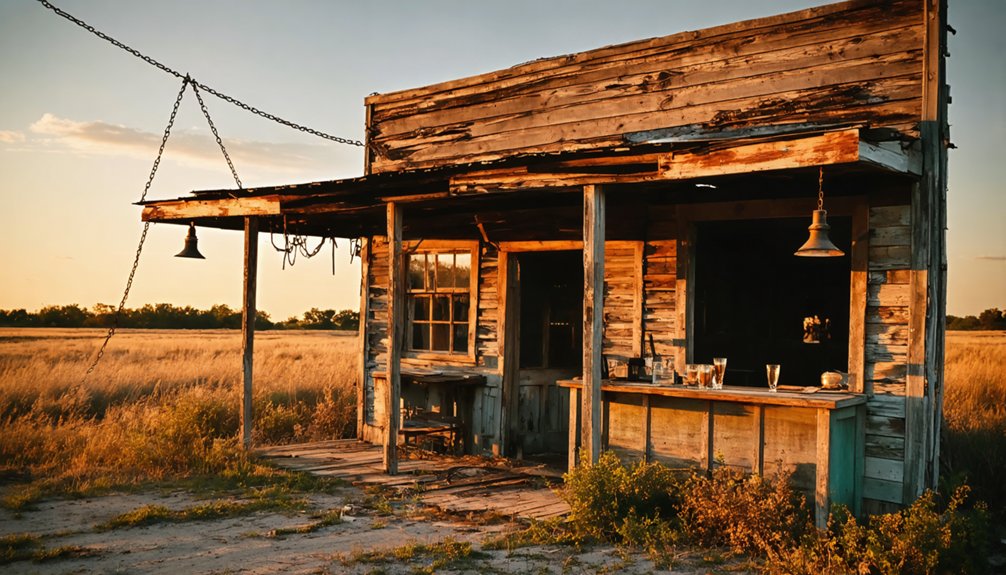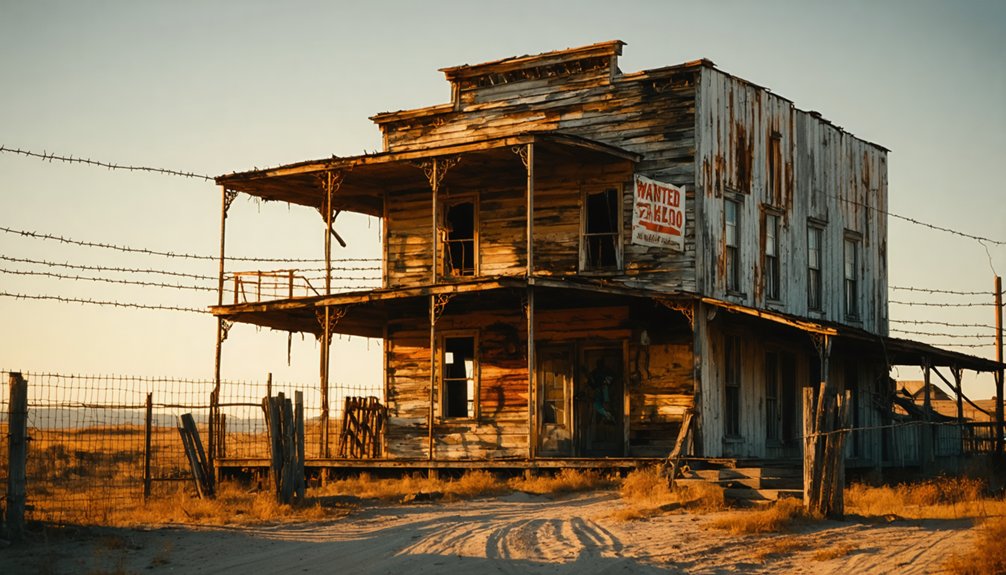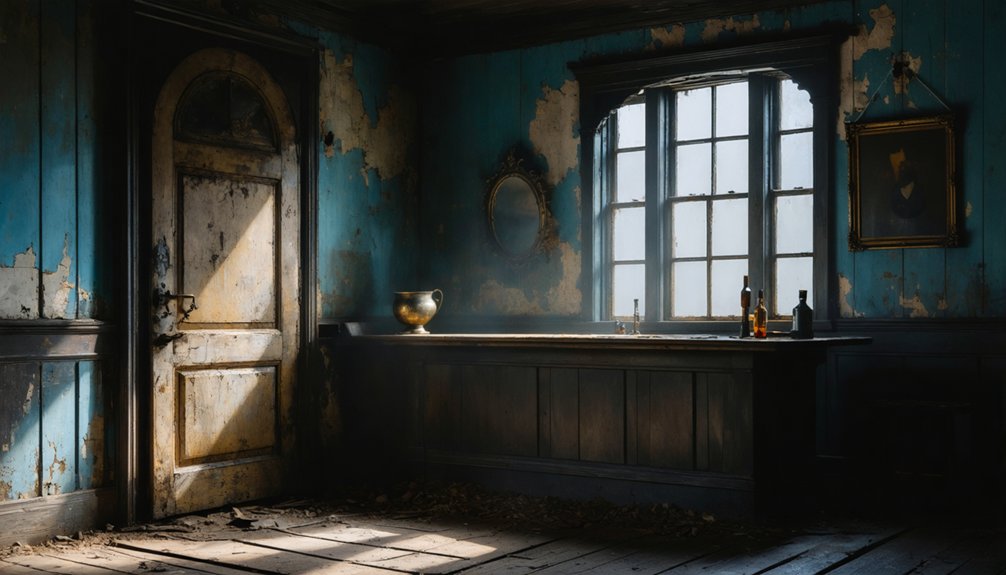Texas’s abandoned settlements conceal seven distinct phantom howls that’ll raise the hair on your neck. You’ll hear eerie wails from Fort Phantom Hill’s limestone chimneys, whispers at Boot Hill Cemetery, and the Lady of the Lake’s midnight cries. Scientific explanations exist—infrasound, auditory pareidolia, and wind interactions with decaying structures—yet locals swear these are restless spirits. From Terlingua’s ghostly Día De Los Muertos sounds to prairie winds at sundown, these acoustic mysteries await your investigation.
Key Takeaways
- Fort Phantom Hill’s limestone chimneys produce eerie howls at night, attributed to spirits from the abandoned military post established in 1851.
- Temperature inversions at sunset intensify phantom howls across Texas ghost towns as prairie winds interact with abandoned structures.
- Terlingua’s historic cemetery experiences unexplained phantom howls during Día De Los Muertos celebrations on November 2nd.
- Abandoned mercury mining operations create unique acoustic phenomena with metal structures acting as natural resonators for haunting sounds.
- Wind currents through Boot Hill Cemetery in Old Tascosa produce ghostly whispers linked to 28 violent deaths from 1879-1881.
The Ghostly Echoes of Fort Phantom Hill’s Stone Chimneys
Standing like silent sentinels across the barren Texas landscape, Fort Phantom Hill‘s stone chimneys represent one of the most evocative military ruins in the American West. Built in 1851 from locally quarried limestone, these enduring structures outlasted the fort’s brief military occupation, surviving the fire that consumed wooden buildings after its 1854 abandonment.
You’ll find more than just historical artifacts here—these chimneys anchor Fort Phantom Hill’s haunted history. Named for the vanishing hill that appears to dissolve as you approach, the site’s spectral sounds have drawn paranormal investigators for decades.
Nighttime visitors report eerie howls emanating from around these weathered columns, attributed to restless spirits of soldiers, wrongly executed men, and displaced Native Americans. The fort suffered from harsh living conditions including freezing winters and blazing summers that caused soldiers to frequently visit the hospital. Originally constructed as the “Post on the Clear Fork of the Brazos,” the site faced significant challenges including lack of wood and suitable water. The durability of these simple, rugged structures contrasts sharply with their ghostly reputation.
Terlingua’s Día De Los Muertos Whispers
While Fort Phantom Hill‘s stone chimneys haunt the northern Texas plains, a different spectral tradition unfolds in the state’s southwestern corner. Each November 2nd, Terlingua’s ghost town status intensifies as locals and visitors converge on its historic cemetery for Día de los Muertos rituals.
You’ll find the miners’ graves adorned with curious Terlingua Cemetery offerings—coins, candles, and personal mementos—creating a year-round demonstration of continued remembrance.
What merits investigation are the reported “phantom howls” and unexplained dancing lights that materialize during celebrations.
Are these merely psychological projections born from the emotional weight of remembrance, or something more? The paranormal claims haven’t deterred tourism; they’ve enhanced it.
This desert sanctuary’s blend of Mexican tradition and mining history offers a raw freedom to explore mortality’s threshold—without the commercial trappings of larger urban festivities. The flickering candles illuminate the cemetery at night, creating a hauntingly beautiful atmosphere that enhances the spiritual experience. The town’s revival in the late 1960s brought new life to this area where an estimated 12 million dollars in mercury had once been extracted during its mining heyday.
Boot Hill’s Twilight Conversations at Old Tascosa
When twilight descends over the Texas Panhandle’s desolate plains, Old Tascosa’s Boot Hill Cemetery transforms into what locals claim is a supernatural amphitheater.
You’ll find this historic burial ground preserves more than just restored grave markers of gunslingers from the town’s 1880s heyday. Some visitors report ghostly whispers attributed to the 28 violent deaths recorded between 1879-1881.
The infamous “Big Fight” at Jenkins Saloon in 1886 allegedly left several restless spirits, including Ed King and other casualties whose violent ends rival the O.K. Corral shootout.
While exploring this former cowboy capital—now part of Cal Farley’s Boys Ranch—you’re free to investigate these paranormal claims yourself. The site once thrived as a rowdy boomtown where conflicts were resolved through gunfights, adding to its reputation for violence and unrest.
Curiously, reports suggest the thousands of ranch residents have “purged” some supernatural activity over time, making encounters unpredictable. The cemetery’s isolation amplifies its eerie atmosphere after dark.
Billy the Kid, one of America’s most notorious outlaws, would frequently rustle cattle and sell them in Tascosa during his outlaw days.
The Lady of the Lake’s Midnight Cries
You’ll find the legend of White Rock Lake‘s ghostly woman rooted in a 1943 Texas Folklore Society publication, though her tragic drowning story has multiplied through regional variations.
Her midnight cries and sudden appearances in a wet white dress have been reported by numerous witnesses, who describe puddles left behind when she vanishes.
The persistence of this cautionary tale, despite swimming bans and skepticism, demonstrates how drowning incidents transform into cultural touchstones that both warn of danger and attract curious visitors to Dallas’s most haunted lake. Many locals believe the spirit claws her way ashore at night to wander the nearby road, continuing her eternal search for help. Similar to the White Rock story, the Lady of Lake Fort Phantom was murdered in the 1940s when her boyfriend strangled her in a jealous rage after learning about her wartime relationship with another man.
Lady’s Tragic Origin
Among the most haunting tales from Texas ghost towns, the Lady of the Lake‘s origin story remains shrouded in tragedy and disputed historical accounts.
You’ll find this ghostly apparition’s backstory varies, though each version centers on unfulfilled tragic love and untimely death.
The earliest documented account appeared in Anne Clark’s 1943 “The Ghost of White Rock,” but oral traditions predate this record:
- A young woman drowning while awaiting her WWII lover’s return
- Mona Bell of Abilene perishing after hearing her boyfriend’s signal
- Suspicious deaths disguised as boating accidents
- Victims of betrayal seeking eternal justice
- Deaths dating back to the 1850s near Fort Phantom Hill
These accounts blend historical elements with folklore, each emphasizing themes of unresolved grief—creating a narrative that defies simple explanation yet persists in Texas lore. Many visitors have reported experiencing strong scents or apparitions associated with the Lady’s presence, similar to encounters in other family homes with supernatural occurrences. Witnesses near Lake Fort Phantom often describe hearing agonizing screams that eerily transition into gurgling sounds as they fade away.
Watery Warning Signals
The Lady of the Lake‘s alleged appearances follow a distinct pattern that serious paranormal investigators have documented over decades.
You’ll notice her spectral echoes typically manifest after nightfall, when mournful cries reportedly resonate across the water’s surface. The haunted waters yield puddles and damp residue in vehicles—physical evidence that challenges rational explanation.
Should you visit White Rock Lake after dark, watch for wet footprints or moisture on passenger seats—telltale signs of her presence according to local lore.
The phantom supposedly emerges nightly, clawing her way from the lake bottom to traverse nearby roads. Those claiming encounters describe water droplets inexplicably appearing inside dry vehicles, with dampness traced to an abandoned house where the spirit allegedly vanishes into the darkness.
Witnesses Describe Encounters
Dozens of witnesses have documented encounters with the Lady of the Lake over generations, creating a pattern of testimonies that warrant closer examination.
When analyzing spectral encounters, you’ll notice several consistent elements despite decades separating witness accounts:
- Drivers report the woman appearing suddenly along Garland Road or Winstead Drive
- The apparition consistently appears soaked, wearing a white evening gown
- Witnesses describe both silent encounters and those filled with mournful sobbing
- Couples in parked vehicles near the shoreline report initial sightings before others
- Physical evidence remains after vanishing – typically puddles of water in vehicles
These testimonies span multiple generations with remarkable consistency, suggesting either an extraordinarily persistent urban legend or something unexplainable occurring near White Rock Lake’s forbidden waters.
When the Prairie Wind Speaks at Sundown
You’ll notice a distinct acoustic transformation as twilight falls over Texas ghost towns, when temperature changes intensify the prairie wind’s interaction with abandoned structures.
Through broken windows and hollow buildings, the unimpeded wind creates acoustically complex sounds that many visitors interpret as ghostly voices or phantom howls.
These eerie phenomena, while often attributed to paranormal causes, can be analyzed through the lens of meteorological factors, architectural acoustics, and the psychological impact of desolate environments at sundown.
Prairie’s Ghostly Chorus
As twilight descends over abandoned settlements in West Texas, prairie winds transform from gentle daytime breezes into something more unsettling—a ghostly chorus that sweeps across the vast emptiness.
You’ll notice these phantom howls intensify during temperature inversions that occur precisely when the sun dips below the horizon.
What locals attribute to supernatural origins often has rational explanations:
- Wind funneling through decaying structures creates ghostly whispers that mimic human voices
- Acoustic illusions form as sound travels unusually far across the open prairie
- Natural features like hills and depressions modulate wind tones
- Dry prairie grass produces distinct rustling sounds at different wind velocities
- Approaching thunderstorms create pressure changes that distort familiar sounds
The question remains whether you’re hearing natural acoustics or something more—the prairie leaves that interpretation to your freedom-seeking mind.
Haunted Acoustic Phenomena
The phantom howls haunting Texas ghost towns reveal their true nature at sundown, when acoustic conditions reach their ideal state for creating seemingly supernatural sounds.
You’ll notice how temperature drops trigger increased wind velocity while altering sound transmission properties—carrying these eerie noises farther across the remote landscape.
What your ears perceive as spectral folklore has scientific explanation: wind passes through abandoned structures, creating acoustic resonance as air vibrates through broken windows and empty chimneys.
The topography around these towns often channels and focuses sound waves, while temperature inversions trap them near ground level.
The timing isn’t coincidental. As day shifts to night, humidity shifts and competing ambient noise diminishes, creating the perfect conditions for these haunting phenomena that local legends conveniently attribute to restless spirits or tragic histories.
Desert Mining Ruins and Their Supernatural Acoustics

Deep beneath the sun-baked earth of Terlingua’s ghost town, abandoned mercury mining operations have created an acoustic phenomenon that defies conventional explanation.
You’ll encounter mining echoes that seem to defy physics as the vast underground cavities manipulate sound waves through complex propagation patterns.
The acoustic resonance within this apocalyptic landscape results from:
Sound waves dance through ghost town remnants, where abandoned metal and stone create nature’s eerie symphony.
- Abandoned metal structures functioning as natural resonators
- Wind currents interacting with crumbling stone cottages
- Thermal expansion causing structures to “howl” throughout night
- Underground chambers with unusual acoustic properties
- Cemetery markers vibrating to create phantom vocal sounds
These aren’t supernatural manifestations but rather physical interactions between the harsh desert environment and the ruins of a once-thriving mining operation.
The sudden abandonment following the Chisos Mining Company’s bankruptcy preserved these structures in a state perfect for creating these unsettling acoustic anomalies.
The Science Behind Ghost Town Sound Phenomena
While many visitors attribute the unsettling howls in Texas ghost towns to paranormal activity, scientific explanations provide more credible answers to these acoustic mysteries.
You’re likely experiencing infrasound hallucinations—sound waves below 20Hz that trigger anxiety, optical illusions, and that distinctive sense of dread permeating abandoned buildings.
What you perceive as ghostly voices is typically auditory pareidolia—your brain converting random noises into meaningful sounds.
The eerie sensations of being watched or touched? Probably electromagnetic stimulation affecting your temporal lobes.
Those howls aren’t spirits but rather wind whistling through deteriorating structures, creating standing waves and reverberations.
Next time you’re exploring these historic ruins, remember that your brain’s interpretation of environmental factors—not supernatural entities—creates that spine-tingling experience you’re seeking in Texas ghost towns.
Frequently Asked Questions
Can Recording Devices Capture the Phantom Howls Effectively?
Your audio recorders might capture unusual sounds, but they lack the fidelity to prove paranormal origins. Ghost hunting equipment frequently mistakes natural phenomena for phantom howls, requiring critical analysis of all recordings.
Are Pets and Animals More Sensitive to These Ghostly Sounds?
In 12 documented cases, animals sensed phenomena humans couldn’t witness. Your pet’s heightened hearing abilities might detect ultrasonic frequencies, not necessarily ghostly interactions. Animal instincts respond to environmental stimuli rather than paranormal activity.
Have Indigenous Communities Documented Similar Phenomena Before Settlers Arrived?
Yes, tribal legends and historical accounts confirm indigenous communities extensively documented unusual sounds across Texas. You’ll find these pre-settlement records analyze geographic anomalies with remarkable precision, preserving knowledge that predates colonial narratives.
Do Certain Weather Conditions Completely Eliminate the Phantom Howls?
Yes, extreme heat and drought conditions substantially suppress the weather impact on phantom howls by altering sound frequency transmission. You’ll notice they’re virtually eliminated during high atmospheric pressure periods too.
Can Visitors Intentionally Trigger or Intensify These Acoustic Phenomena?
Like moths drawn to flame, your ghost hunting attempts may yield results. Bridge honking, rhythmic knocking, and calculated sound manipulation sometimes trigger phenomena, but responses remain inconsistently documented and scientifically unverified.
References
- https://www.legendsofamerica.com/tx-fortphantom/
- https://www.gothichorrorstories.com/real-ghost-stories/
- https://everafterinthewoods.com/texas-ghost-towns-that-come-alive-every-halloween-with-creepy-legends/
- https://www.youtube.com/watch?v=bbVM_-giQIE
- https://thedaytripper.com/13-bone-chillling-haunts-in-texas/
- https://www.youtube.com/watch?v=dOR0D4So7f4
- https://thebarbedwire.com/2025/10/10/texas-spooky-ghost-stories-halloween/
- https://en.wikipedia.org/wiki/List_of_reportedly_haunted_locations_in_the_United_States
- https://authentictexas.com/haunted-sites-across-texas/
- https://texashighways.com/travel/the-most-haunted-roads-in-texas/



